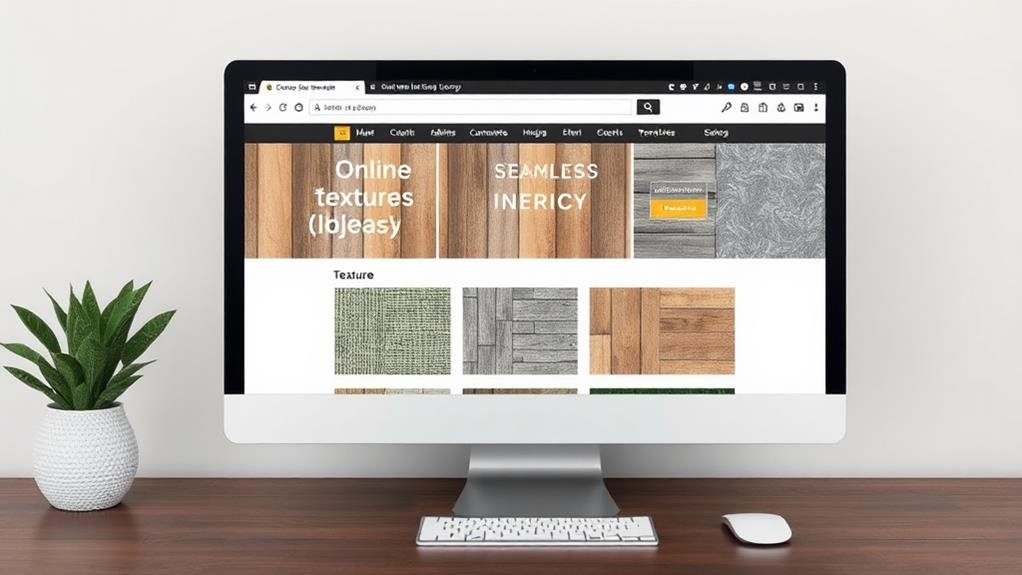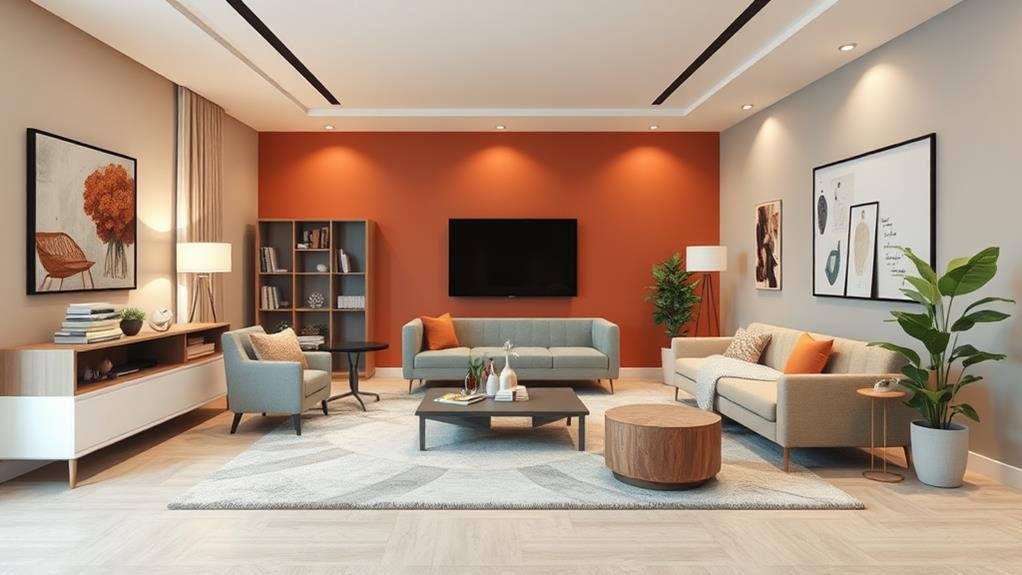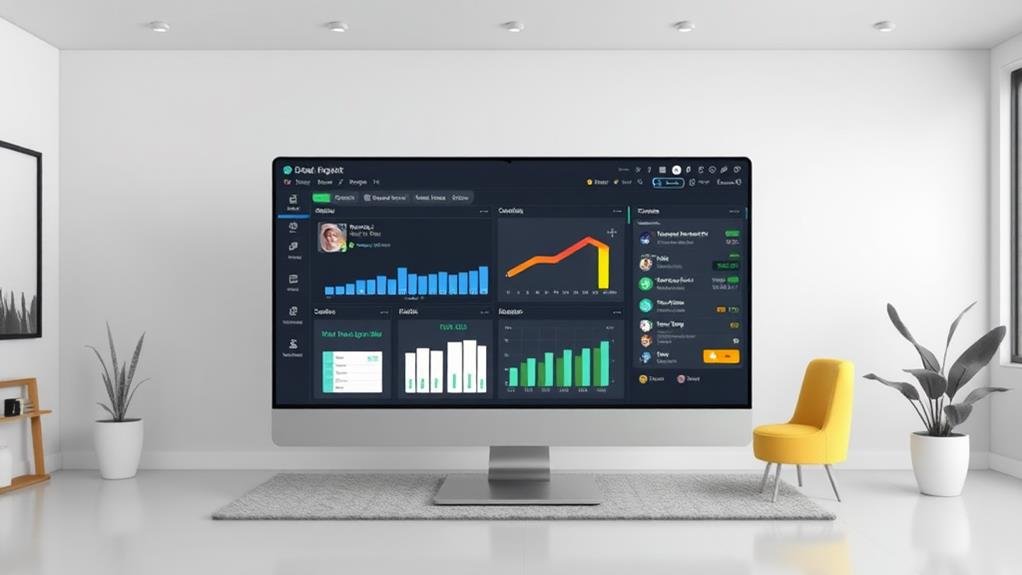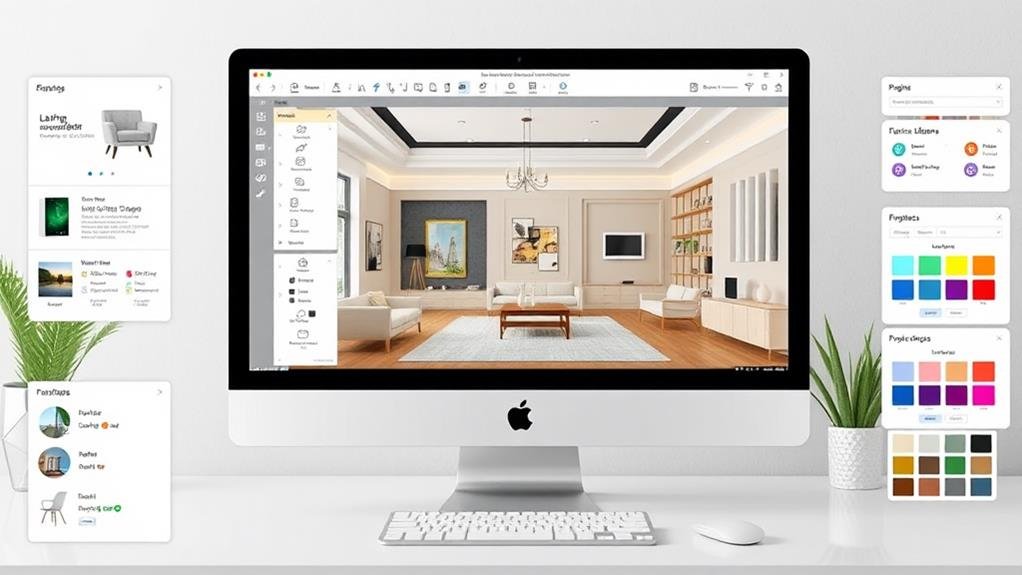To excel in 3D interior design, immerse yourself in cutting-edge tools like 3D modeling software for detailed virtual models, rendering tools for photorealistic images, and texturing programs for intricate textures. Light up your designs using strategic lighting systems and explore new dimensions with virtual reality headsets. Collaborate seamlessly using platforms, manage projects efficiently with specialized software, and enhance creativity with interior design plugins. For a cinematic touch, explore video editing tools like Adobe Premiere Pro and Final Cut Pro. Elevate your designs with these essential tools and watch your creativity soar to new heights.
Key Takeaways
- 3D Modeling Software for detailed virtual interior models with tailored features.
- Rendering Tools transform 3D models into photorealistic images or videos efficiently.
- Texturing Programs control intricate textures for realism and appeal.
- Lighting Systems shape ambiance; balance natural and artificial lighting for energy efficiency.
- Virtual Reality Tools offer immersive design experiences, enhancing spatial awareness and client feedback.
3D Modeling Software

When embarking on a journey into the world of 3D interior design, one indispensable tool that will be your creative ally is 3D modeling software. These programs are essential for creating detailed and realistic virtual models of interior spaces.
As you delve into the realm of 3D modeling techniques, you'll find that different software options offer unique features tailored to varying needs. Consider software comparisons to choose one that aligns best with your workflow optimization and design automation preferences. The user interface design plays a crucial role in your efficiency, so ensure the software you select is intuitive and user-friendly.
Additionally, compatibility considerations are vital for seamless integration with other tools in your pipeline while meeting industry standards.
Educational resources such as beginner tutorials can help you grasp the basics, while exploring advanced features will elevate the quality of your designs. By leveraging the capabilities of 3D modeling software effectively, you unlock a world of creative possibilities in interior design.
Rendering Tools

As you navigate the intricate world of 3D interior design, the next step in bringing your visions to life involves exploring the realm of rendering tools. Rendering tools play a crucial role in transforming your 3D models into photorealistic images or videos through various rendering techniques.
When selecting rendering software, consider factors such as performance optimization, user interface, rendering speed, and handling of scene complexity. Comparing different software options can help you find the right fit for your needs.
Additionally, utilizing cloud rendering services can accelerate your rendering process by harnessing vast computing power.
Post-processing effects can add depth and realism to your renders, enhancing the final output. Visualizing strategies to efficiently manage rendering resources and output formats can streamline your workflow.
Texturing Programs

To enhance the intricate textures within your 3D interior designs, you must delve into the realm of texturing programs. These powerful tools allow you to meticulously control every aspect of the textures in your virtual spaces.
Starting with material selection, you can pick from a myriad of options to create surfaces that feel real and visually appealing. Texture mapping enables you to apply patterns seamlessly, while UV unwrapping ensures that textures fit perfectly on your models.
Dive into surface detailing to add depth and realism to your designs, using color theory to achieve visual consistency. Texture blending helps in creating seamless transitions between different materials, enhancing design cohesion.
Lighting Systems

Consider the pivotal role lighting systems play in shaping the narrative of your interior design projects.
The choice between natural and artificial lighting influences the atmosphere, while utilizing layered light sources can enhance depth and dimension.
Crafting the right mood and ambiance through strategic lighting placement can elevate your 3D renderings to evoke specific emotions in viewers.
Natural vs. Artificial
When designing the lighting system for your 3D interior space, a crucial decision to make is whether to prioritize natural or artificial lighting.
Natural lighting provides a sense of connection to the outdoors, enhancing design aesthetics and mood. It can positively impact emotional well-being and create a welcoming environment.
On the other hand, artificial lighting offers control over color temperature, light diffusion, and can manipulate space perception within your design. It plays a vital role in setting the mood and highlighting specific areas in the room.
Considering energy efficiency and sustainable design, a balance between natural and artificial lighting is ideal.
Natural light reduces the need for artificial sources during the day, cutting down energy consumption. Integrating both types of lighting can lead to a harmonious blend that maximizes the space's potential while being environmentally conscious.
Layered Light Sources
Diving into the intricacies of 3D interior design, the concept of layered light sources emerges as a pivotal element in creating captivating visual dynamics within a space.
To master this art, consider the following:
- Ambient Lighting: Establish a base level of illumination to provide overall visibility and comfort.
- Task Lighting: Direct light to specific work or activity areas for enhanced functionality.
- Accent Lighting: Highlight focal points or architectural features to add depth and interest.
- Layered Textures: Play with light and shadow to emphasize the textures and materials within the design.
Intentional selection of light color, fixture types, and precise lighting placement align with core design principles.
Ensure energy efficiency through smart choices while also exploring the dramatic effects shadows can cast.
Mood and Ambiance
Exploring 3D interior design further unveils the transformative impact lighting systems can exert on the mood and ambiance of a space.
Lighting plays a crucial role in setting the tone and creating the desired atmosphere. Understanding color psychology is essential when selecting lighting, as different hues can evoke varied emotions.
Spatial awareness is key; strategic placement of lights can enhance the perception of space and highlight specific design elements.
Keeping up with design trends is important, but personal preferences shouldn't be overlooked. Cultural influences can also guide lighting choices, ensuring they align with the overall theme.
The emotional impact of lighting shouldn't be underestimated; it can significantly affect the mood of the room. Careful consideration of material choices for light fixtures is crucial for style cohesion and aesthetic balance.
Effective client communication is vital to understand their lighting preferences.
Virtual Reality Headsets

Strap on a Virtual Reality headset and step into a world where your interior design visions come to life right before your eyes.
The immersive experience will transport you into your creations, allowing you to feel the space and design in a whole new way.
With enhanced visualization capabilities, you can explore every detail, ensuring a perfect design before it even becomes reality.
Immersive Design Experience
To fully immerse yourself in the world of interior design like never before, consider embracing the cutting-edge technology of virtual reality headsets.
Virtual reality offers an immersive design experience that enhances your understanding of spatial awareness and empowers you to create captivating interiors.
- Enhanced User Experience: Virtual reality allows you to navigate through your designs in a lifelike environment, providing a unique perspective that traditional methods can't match.
- In-depth Design Psychology: By experiencing your design concepts in virtual reality, you can better analyze the emotional impact of different elements on the user, aiding in creating spaces that resonate with clients.
- Real-time Client Interaction: Share your virtual reality designs with clients to ensure that everyone is on the same page and make adjustments based on real-time feedback.
- Sensory Engagement: Through virtual reality, you can fully immerse yourself in the ambiance of your designs, focusing on elements like lighting, textures, and acoustics for a multi-sensory experience.
Enhanced Visualization Capabilities
Immerse yourself in a world where your interior design visions come to life with the advanced capabilities of virtual reality headsets.
When utilizing VR technology in your design process, you can delve into a realm where color theory, space planning, and design trends merge seamlessly.
With a focus on user experience, material selection, and ergonomic considerations, VR enables you to explore every detail with precision.
Integrating style preferences and client requirements becomes more tangible as you navigate through virtual spaces, experimenting with different layouts and furniture arrangements to meet their needs.
Additionally, VR aids in assessing design sustainability, offering valuable insights into energy-efficient solutions and eco-friendly materials.
Graphic Tablets

Enhancing your 3D interior design projects with precision and creativity requires the right tools, and graphic tablets are an essential instrument in your toolkit.
Graphic tablets offer a range of features that can significantly elevate your design process:
- Pressure Sensitivity: Allows you to control line weight and opacity with varying degrees of pressure, mimicking traditional drawing techniques.
- Design Precision: Enables you to execute intricate details with accuracy, enhancing the overall quality of your designs.
- Surface Texture: Some tablets come with textured surfaces that provide a tactile feel, enhancing your drawing experience.
- Ergonomic Features: Designed for prolonged use, these tablets offer adjustable stands and ergonomic stylus designs to reduce strain and increase comfort during long working hours.
These features, coupled with stylus customization and artistic versatility, streamline your digital sketching, improve your creative workflow, and provide an intuitive interface for seamless interaction with your designs.
Additionally, consider the portability options when choosing a tablet to ensure flexibility in your workspace.
Computer Hardware

Graphic tablets have revolutionized the way designers bring their ideas to life, but behind every stroke of creativity lies a robust foundation: computer hardware.
When diving into 3D interior design, your computer's graphic card performance, processing power, display resolution, and storage capacity are crucial. High graphic card performance ensures smooth rendering of intricate designs, while sufficient processing power supports complex simulations and modeling tasks.
Opt for a display with high resolution to visualize your designs in crisp detail. Ample storage capacity is needed to store project files, references, and software suites. Efficient cooling solutions are vital to prevent overheating during intensive design sessions.
Consider peripheral devices like graphic tablets, ergonomic keyboards, and high-quality monitors to enhance your workstation setup. Select hardware with upgrade options for longevity and compatibility with the latest design software.
A well-configured computer ensures multitasking efficiency, allowing you to seamlessly switch between various design tasks.
Online Texture Libraries

Unlock endless possibilities for adding depth and realism to your 3D interior designs by tapping into the vast resources of online texture libraries.
When exploring these virtual treasure troves, consider the following:
- Texture Sourcing Strategies: Explore various websites and platforms to find textures that align with your design vision.
- Library Organization Tips: Create a systematic approach to categorize and store textures for easy access during your projects.
- Licensing Considerations: Understand the usage rights for each texture to avoid copyright infringement and ensure compliance.
- User Generated Textures: Leverage user-generated content for unique and fresh textures that stand out in your designs.
Incorporating these textures into your projects involves techniques such as texture mapping, blending methods, and compatibility checks.
Furthermore, optimizing your workflow with resolution analysis and reviewing online resources can elevate the quality of your designs.
Embrace the digital era's abundance of textural resources to bring your 3D interiors to life.
Collaboration Platforms

Imagine a virtual workspace where you can seamlessly share your 3D interior design projects in real-time with clients and collaborators from around the world.
Picture receiving instant feedback and engaging in interactive discussions that elevate your designs to new heights.
That's the power of collaboration platforms in revolutionizing the way you work and connect with others in the field of interior design.
Real-Time Design Sharing
Enhance your 3D interior design projects through the power of real-time design sharing platforms that facilitate seamless collaboration among team members and clients.
These platforms enable efficient communication, allowing for instant feedback and iterative improvements to your designs. Here are some key benefits of utilizing real-time design sharing tools:
- Instant Communication: Stay connected with your team and clients in real time, ensuring swift responses to queries or design feedback.
- Simultaneous Editing: Collaborate on designs simultaneously, boosting productivity and creativity through shared virtual workspaces.
- Version Control: Keep track of design iterations and changes made by different team members, ensuring consistency across the project.
- Enhanced Client Engagement: Allow clients to interact with the design process actively, fostering greater involvement and satisfaction with the final results.
With real-time design sharing platforms, you can create dynamic and engaging interior designs while fostering a collaborative environment that leads to exceptional outcomes.
Interactive Feedback Exchange
Revolutionize the way you gather feedback and collaborate on your 3D interior design projects with interactive feedback exchange platforms, commonly known as Collaboration Platforms. These platforms are essential for seamless client communication and efficient design feedback integration.
Collaboration Platforms provide a dynamic space for design teams, clients, and stakeholders to interact in real-time. They allow for instant feedback exchanges, cutting down on lengthy email chains and miscommunications. Clients can pinpoint specific areas they want to address, making it easier for designers to implement changes quickly.
These platforms often offer features like annotation tools, where clients can mark directly on designs, highlighting what they like or want to modify. This direct visual feedback enhances communication and ensures design accuracy.
Furthermore, Collaboration Platforms streamline the approval process, as all parties can review and comment on the same platform, fostering a cohesive and productive workflow.
Project Management Software

Utilizing the right project management software is akin to equipping yourself with a virtual toolkit that streamlines and organizes every aspect of your 3D interior design projects.
When selecting project management software for your 3D interior design work, consider the following key features:
- Task Allocation: Efficiently assign tasks to team members and track their progress.
- Timeline Tracking: Monitor project timelines to ensure timely completion of milestones.
- Client Communication: Facilitate seamless communication with clients to provide updates and gather feedback.
- Resource Management: Optimize resource allocation to avoid bottlenecks and maximize efficiency.
Project management software streamlines budget estimation, team collaboration, progress monitoring, risk assessment, document sharing, and milestone setting.
By incorporating these features, you can enhance the organization, communication, and overall success of your 3D interior design projects.
Choose a comprehensive tool that aligns with your specific project needs to boost productivity and achieve remarkable results.
Interior Design Plugins

When diving into the realm of 3D interior design, incorporating the right Interior Design Plugins can significantly elevate your creative process and productivity.
Plugins play a crucial role in keeping up with interior design trends, streamlining workflows, and enhancing your designs. Before choosing a plugin, ensure compatibility to avoid plugin compatibility issues that may hinder your progress.
Look for plugins with intuitive user interface design and performance optimization techniques for a seamless experience. Consider features like cost-effective solutions, beginner-friendly options, and advanced functionalities for a comprehensive interior design experience.
Keep in mind essential features comparisons when selecting plugins for your projects. Explore a roundup of top plugins to find the best fit for your needs.
Additionally, consider plugin installation tips to maximize efficiency in your workflow. By incorporating the right plugins, you can take your 3D interior design projects to new heights.
Video Editing Tools

Discover a world of boundless creativity and seamless storytelling with the array of Video Editing Tools at your disposal.
- Adobe Premiere Pro: Dive into the realm of professional video editing techniques with this powerful software that offers precise editing tools and seamless integration with other Adobe products.
- Final Cut Pro: Unleash your creativity with this Mac-based software known for its intuitive interface and advanced features that elevate your video editing skills to the next level.
- DaVinci Resolve: Experience the ultimate control over your video editing process with this software that combines editing, color correction, visual effects, and audio post-production in one platform.
- Blender: Delve into the world of animation software with Blender, a versatile tool that not only supports 3D modeling but also provides extensive video editing capabilities for a complete multimedia experience.
With these video editing tools at your fingertips, you can bring your 3D interior designs to life through captivating animations and immersive storytelling techniques.
Elevate your projects and engage your audience in a visually stunning journey through your creative vision.
Conclusion
Now that you have all the essential tools for 3D interior design, you're ready to bring your visions to life. While it may seem overwhelming at first, remember that practice makes perfect. Don't be alarmed if you run into some technical difficulties along the way – everyone does! Embrace the learning process and don't be afraid to ask for help or seek out tutorials online. The world of 3D interior design is waiting for you to explore and create something truly amazing.

